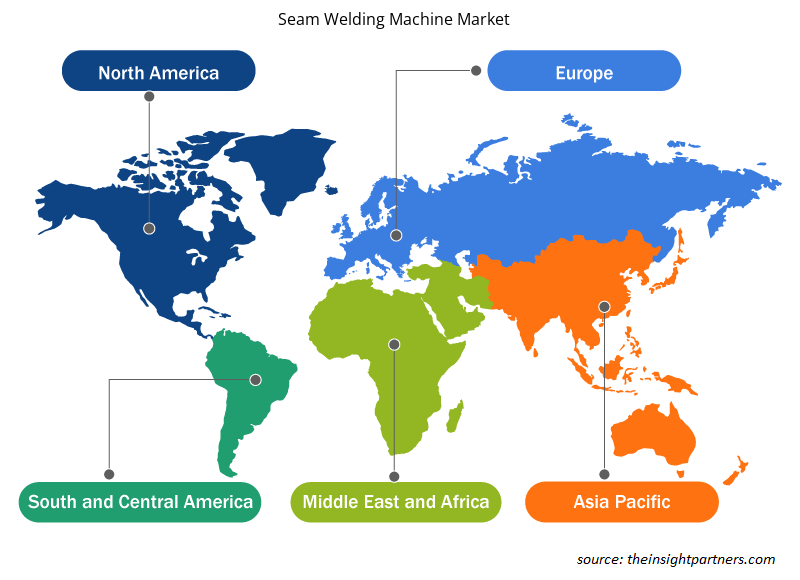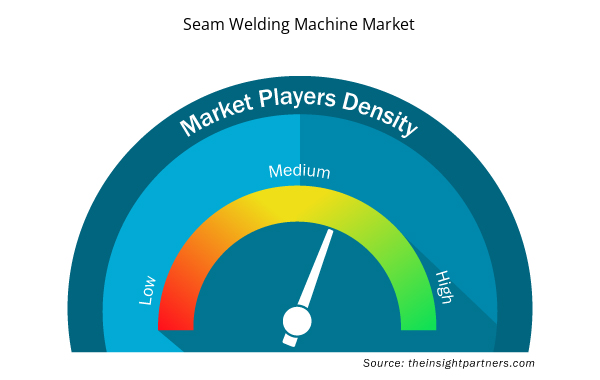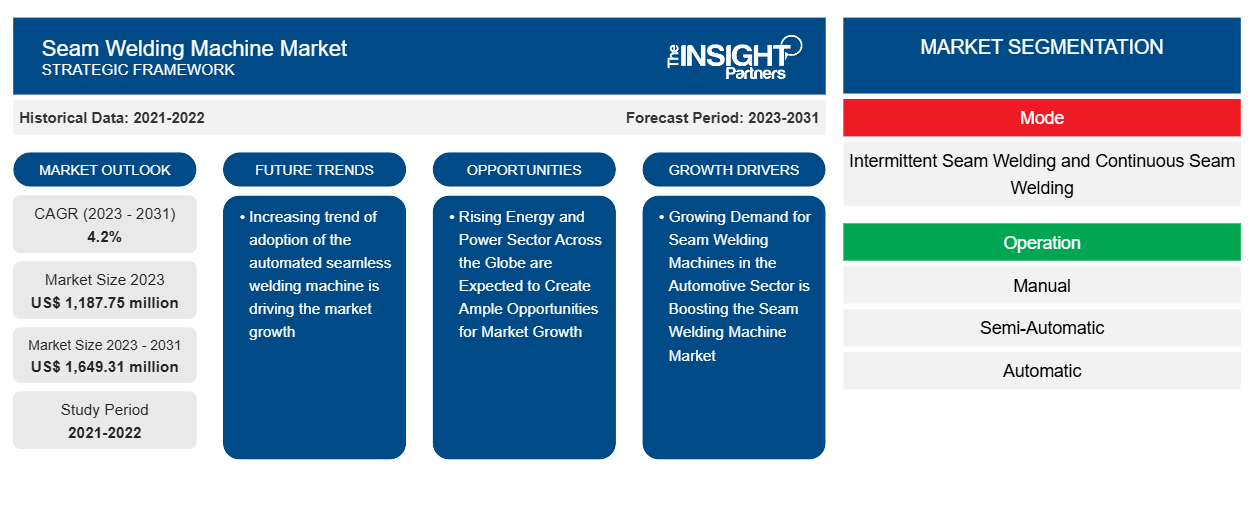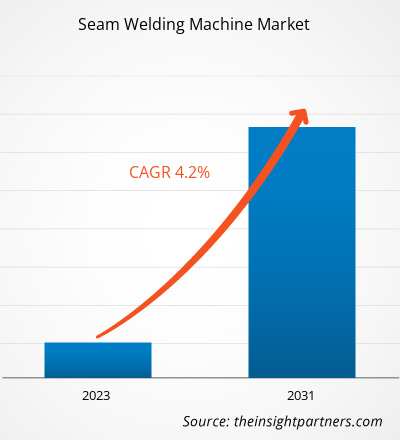缝焊机市场规模预计将从 2023 年的 11.8775 亿美元增至 2031 年的 16.4931 亿美元。预计 2023-2031 年市场复合年增长率为 4.2%。缝焊机由一个或两个电动轮组成,可在钢板部件上形成一系列重叠的点焊,以实现焊接部件的防气防液密封。无缝电流通过这些辊板,焊接部件被压在它们之间。汽车、工业制造、建筑能源和电力等不同行业对缝焊机的需求不断增长,推动了预测期内市场的增长。
缝焊机市场分析
缝焊机市场主要由亚太国家主导,例如印度、中国、韩国、日本等。这是由于亚太国家汽车制造厂的需求不断增长推动了市场增长。2023 年,印度汽车零部件制造进口额达到 203 亿美元,其中来自中国的份额高达 30%。印度政府正在推动国内电动汽车制造,推动缝焊机市场增长。
定制此报告以满足您的需求
您可以免费定制任何报告,包括本报告的部分内容、国家级分析、Excel 数据包,以及为初创企业和大学提供优惠和折扣
- 获取此报告的关键市场趋势。这个免费样品将包括数据分析,从市场趋势到估计和预测。
缝焊机市场概况
缝焊机市场驱动因素和机遇
汽车行业对缝焊机的需求不断增长,推动了缝焊机市场的发展
2022 年汽车产量较 2023 年增长 11.5%,全球汽车产量约为 9200 万辆。产量增长主要推动了领先汽车 OEM 对先进机器的需求,例如用于汽车面板制造的机器人焊接无缝焊接机。全球发达经济体汽车产量的快速增长推动了汽车行业缝焊机市场的增长。此外,随着混合动力电动汽车的出现,电动汽车产量不断上升,在缝焊机市场越来越受欢迎。
全球能源和电力行业的崛起预计将为市场增长创造充足的机会
能源和电力行业对太阳能电池板支架和工业锅炉制造的需求不断增加,预计将在预测期内为缝焊机市场增长创造充足的机会。例如,2024 年 1 月,Mortenson 和 Terra-Gen 在美国启动了最大的太阳能电池板和储能项目,名为 Edwards & Sanborn Solar。Mortenson 是该项目在美国的采购、工程和施工服务承包商。预计在预测期内,全球范围内此类项目的增加将为全球缝焊机市场增长创造充足的机会。Mortenson and Terra-Gen launched the largest solar panel and energy storage project named Edwards & Sanborn Solar in the US. Mortenson is the procurement, engineering, and construction service contractor for this project in the US. Increasing such projects across the globe is expected to create ample opportunity for the global seam welding machine market growth during the forecast period.
缝焊机市场报告细分分析
有助于得出缝焊机市场分析的关键部分是模式、操作和行业。
- 根据模式,市场分为间歇缝焊和连续缝焊。其中,由于全球汽车生产需求不断增长,连续缝焊占有最大份额。
- 根据操作,缝焊机市场分为手动、半自动和全自动。
- 根据行业,市场分为建筑、汽车、石油和天然气、制造业和其他。其中,汽车行业在 2023 年占有最大份额,这是由于全球汽车产量不断增加。
缝焊机市场份额按地区分析
缝焊机市场报告的地理范围主要分为五个区域:北美、亚太、欧洲、中东和非洲、南美/南美和中美。
根据地理位置,缝焊机市场主要分为北美、欧洲、亚太地区 (APAC)、中东和非洲 (MEA) 和南美 (SAM)。预计亚太地区将在 2023 年占据最大的市场份额,并且很可能在预测期内保持主导地位。此外,预计该地区的缝焊机市场在预测期内将出现最高的复合年增长率。这是由于中国、日本和印度等亚太国家的汽车产量增加。例如,2023 年,印度汽车制造商计划到 2028 年投资超过 70 亿美元,以加强其本地汽车零部件生产,如电动机、汽车面板、底盘等。此外,2024 年 3 月,Autoneum 计划扩大其在亚太国家(如中国和印度)的生产。该公司计划在印度西部的浦那和中国吉林长春开设两家新工厂。亚太国家对汽车领域的投资不断增加,为缝焊机市场的增长创造了巨大的需求。
预计到 2023 年,欧洲将占据缝焊机市场的第二大份额。相比之下,德国预计将成为区域缝焊机市场的主要贡献者。欧洲是顶级汽车制造商的所在地,包括梅赛德斯、大众、斯柯达、宝马和奥迪。根据经济、科学和生活质量政策部的数据,由于 2020 年 3 月至 5 月汽车工厂关闭,COVID-19 疫情间接影响了 110 多万个工作岗位。
此外,2020 年欧洲各地的汽车销量暴跌,而原始设备制造商 (OEM) 宣布进一步推迟重新开放装配厂。除了对乘用车和轻型商用车的需求下降之外,由于跨境流动限制导致原材料供应链中断,导致焊机等设备供应延迟。然而,COVID-19 疫情及其影响促使制造公司对其运营进行数字化和自动化,这使它们能够在 2020 年底恢复运营。制造公司的这种复苏努力为欧洲缝焊机供应商创造了未来的增长机会。
缝焊机市场区域洞察
Insight Partners 的分析师已详细解释了预测期内影响缝焊机市场的区域趋势和因素。本节还讨论了北美、欧洲、亚太地区、中东和非洲以及南美和中美洲的缝焊机市场细分和地理位置。

- 获取缝焊机市场的区域特定数据
缝焊机市场报告范围
| 报告属性 | 细节 |
|---|---|
| 2023 年的市场规模 | 11.8775亿美元 |
| 2031 年市场规模 | 16.4931亿美元 |
| 全球复合年增长率(2023 - 2031) | 4.2% |
| 史料 | 2021-2022 |
| 预测期 | 2023-2031 |
| 涵盖的领域 | 按模式
|
| 覆盖地区和国家 | 北美
|
| 市场领导者和主要公司简介 |
|
市场参与者密度:了解其对商业动态的影响
The Seam Welding Machine Market market is growing rapidly, driven by increasing end-user demand due to factors such as evolving consumer preferences, technological advancements, and greater awareness of the product's benefits. As demand rises, businesses are expanding their offerings, innovating to meet consumer needs, and capitalizing on emerging trends, which further fuels market growth.
Market players density refers to the distribution of firms or companies operating within a particular market or industry. It indicates how many competitors (market players) are present in a given market space relative to its size or total market value.
Major Companies operating in the Seam Welding Machine Market are:
- Emerson Electric Co.
- Dahching Electric Industrial
- FranzanKoike Aronson
- Inc.
- Leister Technologies
- CruxweldMiller
Disclaimer: The companies listed above are not ranked in any particular order.

- Get the Seam Welding Machine Market top key players overview
Seam Welding Machine Market News and Recent Developments
The Seam Welding Machine market is evaluated by gathering qualitative and quantitative data post primary and secondary research, which includes important corporate publications, association data, and databases. The following is a list of developments in the market for innovations, business expansion, and strategies:
- In 2022, Stealth, a global manufacturing expert in performance gear, launched a first-to-market, patented seam welding technology that removes the need for stitching. The technology results in warmer, tougher, and entirely durable seams for longer-lasting products that protect adventurers from the harshest elements. (Source: Eurofins, Press Release)
- In 2022, Miller Electric launched a single-wire automated Hercules high-deposition MIG welding system. The Hercules welding system enhances the welding capacity without additional cost requirements related to the welding cells. This is a seamless welding machine with high deposition rates and enhances productivity by up to 30%. (Source: SGS, Newsletter)
Seam Welding Machine Market Report Coverage and Deliverables
The “Seam Welding Machine Market Size and Forecast (2021–2031)” report provides a detailed analysis of the market covering the following areas:
- Seam Welding Machine Market size and forecast at global, regional, and country levels for all the key market segments covered under the scope
- Market dynamics such as drivers, restraints, and key opportunities
- Seam Welding Machine Market Trends
- Detailed PEST Analysis and SWOT analysis
- Seam Welding Machine Market Analysis covering key market trends, Global and regional framework, major players, regulations, and recent market developments.
- Seam Welding MachineMarket Industry landscape and competition analysis covering market concentration, heat map analysis, prominent players, and recent developments.
- Detailed Company Profiles
- Emerson Electric Co.
- Dahching Electric Industrial
- Franzan
- Koike Aronson, Inc.
- Leister Technologies
- Cruxweld
- Miller Weldmaster
- Schnelldorfer Maschinenbau
- 斯必罗国际
- 历史分析(2 年)、基准年、预测(7 年)及复合年增长率
- PEST 和 SWOT 分析
- 市场规模价值/数量 - 全球、区域、国家
- 行业和竞争格局
- Excel 数据集



Report Coverage
Revenue forecast, Company Analysis, Industry landscape, Growth factors, and Trends

Segment Covered
This text is related
to segments covered.

Regional Scope
North America, Europe, Asia Pacific, Middle East & Africa, South & Central America

Country Scope
This text is related
to country scope.
Trends and growth analysis reports related to Manufacturing and Construction : READ MORE..
The Insight Partners performs research in 4 major stages: Data Collection & Secondary Research, Primary Research, Data Analysis and Data Triangulation & Final Review.
- Data Collection and Secondary Research:
As a market research and consulting firm operating from a decade, we have published and advised several client across the globe. First step for any study will start with an assessment of currently available data and insights from existing reports. Further, historical and current market information is collected from Investor Presentations, Annual Reports, SEC Filings, etc., and other information related to company’s performance and market positioning are gathered from Paid Databases (Factiva, Hoovers, and Reuters) and various other publications available in public domain.
Several associations trade associates, technical forums, institutes, societies and organization are accessed to gain technical as well as market related insights through their publications such as research papers, blogs and press releases related to the studies are referred to get cues about the market. Further, white papers, journals, magazines, and other news articles published in last 3 years are scrutinized and analyzed to understand the current market trends.
- Primary Research:
The primarily interview analysis comprise of data obtained from industry participants interview and answers to survey questions gathered by in-house primary team.
For primary research, interviews are conducted with industry experts/CEOs/Marketing Managers/VPs/Subject Matter Experts from both demand and supply side to get a 360-degree view of the market. The primary team conducts several interviews based on the complexity of the markets to understand the various market trends and dynamics which makes research more credible and precise.
A typical research interview fulfils the following functions:
- Provides first-hand information on the market size, market trends, growth trends, competitive landscape, and outlook
- Validates and strengthens in-house secondary research findings
- Develops the analysis team’s expertise and market understanding
Primary research involves email interactions and telephone interviews for each market, category, segment, and sub-segment across geographies. The participants who typically take part in such a process include, but are not limited to:
- Industry participants: VPs, business development managers, market intelligence managers and national sales managers
- Outside experts: Valuation experts, research analysts and key opinion leaders specializing in the electronics and semiconductor industry.
Below is the breakup of our primary respondents by company, designation, and region:

Once we receive the confirmation from primary research sources or primary respondents, we finalize the base year market estimation and forecast the data as per the macroeconomic and microeconomic factors assessed during data collection.
- Data Analysis:
Once data is validated through both secondary as well as primary respondents, we finalize the market estimations by hypothesis formulation and factor analysis at regional and country level.
- Macro-Economic Factor Analysis:
We analyse macroeconomic indicators such the gross domestic product (GDP), increase in the demand for goods and services across industries, technological advancement, regional economic growth, governmental policies, the influence of COVID-19, PEST analysis, and other aspects. This analysis aids in setting benchmarks for various nations/regions and approximating market splits. Additionally, the general trend of the aforementioned components aid in determining the market's development possibilities.
- Country Level Data:
Various factors that are especially aligned to the country are taken into account to determine the market size for a certain area and country, including the presence of vendors, such as headquarters and offices, the country's GDP, demand patterns, and industry growth. To comprehend the market dynamics for the nation, a number of growth variables, inhibitors, application areas, and current market trends are researched. The aforementioned elements aid in determining the country's overall market's growth potential.
- Company Profile:
The “Table of Contents” is formulated by listing and analyzing more than 25 - 30 companies operating in the market ecosystem across geographies. However, we profile only 10 companies as a standard practice in our syndicate reports. These 10 companies comprise leading, emerging, and regional players. Nonetheless, our analysis is not restricted to the 10 listed companies, we also analyze other companies present in the market to develop a holistic view and understand the prevailing trends. The “Company Profiles” section in the report covers key facts, business description, products & services, financial information, SWOT analysis, and key developments. The financial information presented is extracted from the annual reports and official documents of the publicly listed companies. Upon collecting the information for the sections of respective companies, we verify them via various primary sources and then compile the data in respective company profiles. The company level information helps us in deriving the base number as well as in forecasting the market size.
- Developing Base Number:
Aggregation of sales statistics (2020-2022) and macro-economic factor, and other secondary and primary research insights are utilized to arrive at base number and related market shares for 2022. The data gaps are identified in this step and relevant market data is analyzed, collected from paid primary interviews or databases. On finalizing the base year market size, forecasts are developed on the basis of macro-economic, industry and market growth factors and company level analysis.
- Data Triangulation and Final Review:
The market findings and base year market size calculations are validated from supply as well as demand side. Demand side validations are based on macro-economic factor analysis and benchmarks for respective regions and countries. In case of supply side validations, revenues of major companies are estimated (in case not available) based on industry benchmark, approximate number of employees, product portfolio, and primary interviews revenues are gathered. Further revenue from target product/service segment is assessed to avoid overshooting of market statistics. In case of heavy deviations between supply and demand side values, all thes steps are repeated to achieve synchronization.
We follow an iterative model, wherein we share our research findings with Subject Matter Experts (SME’s) and Key Opinion Leaders (KOLs) until consensus view of the market is not formulated – this model negates any drastic deviation in the opinions of experts. Only validated and universally acceptable research findings are quoted in our reports.
We have important check points that we use to validate our research findings – which we call – data triangulation, where we validate the information, we generate from secondary sources with primary interviews and then we re-validate with our internal data bases and Subject matter experts. This comprehensive model enables us to deliver high quality, reliable data in shortest possible time.


 获取此报告的免费样本
获取此报告的免费样本